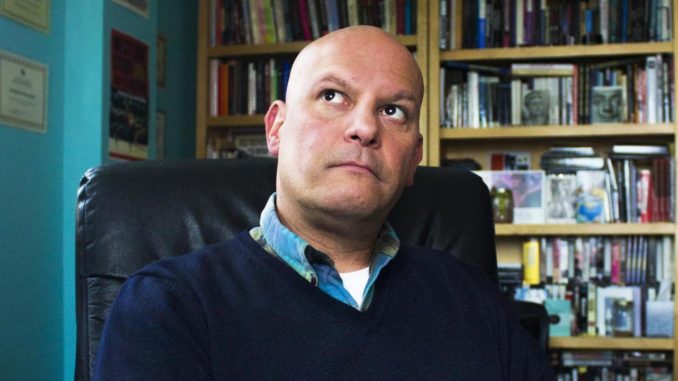
By Gabriela Flores
With the readaptation of “West Side Story” hitting theaters in December, Dr. Ernesto R. Acevedo-Muñoz, one of the film’s historical consultants, joined the Puerto Rican and Latino Studies Department’s (PRLS) ongoing lecture series, “West Side Story: The Brooklyn Connection.”
In conversation with PRLS Deputy Chair María Pérez y González and Brooklyn College Professor Emerita Dr. Virginia Sánchez Korrol, Acevedo-Muñoz discussed how the timeless tale did more than what film critics initially gave it credit for decades ago. He noted how “West Side Story”’ used its musical numbers and artistic merits to showcase social issues experienced by Puerto Ricans and immigrants in America.
“We just go back to ‘West Side Story’ when we want to remind ourselves that the musical can be political and it can be socially conscious,” said Acevedo-Muñoz. “And here we are in 2020, 2021, in a time of great concern. A time of political unrest, social unrest.”
Acevedo-Muñoz’s introduction to “West Side Story” predates his work on the upcoming Steven Spielberg production. Growing up Puerto Rican and playing the musical’s soundtrack on repeat, Acevedo-Muñoz became hooked on the classic despite the cast lacking authentic Latino representation. For him, “West Side Story” was beyond a love story caught between two gangs set in the 1950s, but a step towards acknowledging Puerto Rico on the big screen.
“As a child, I was enamored with ‘West Side Story.’ We’ve never had Puerto Ricans in movies, in any form, even if they were fake Puerto Ricans most of them. But the words ‘Puerto Rico’ were spoken in the soundtrack. We knew it was something unique,” Acevedo-Muñoz said.
His love for the film carried on throughout his life and seeped into his former course “The Hollywood Musical” at the University of Colorado Boulder, where he chairs the Department of Cinema Studies And Moving Image Arts. Throughout past lectures, students constantly asked Acevedo-Muñoz about the classic, which eventually led him to delve nose deep into researching its history.
“I said, ‘Okay, I’m going to write a book on ‘West Side Story.’ I think this needs to be done and I just have to keep some intellectual distance,” said Acevedo-Muñoz. “Because it’s not just going to be a fanboy letter. I have to go deep.”
After visiting different libraries, and searching through numerous boxes of documents detailing the inner workings of the musical’s 1961 version, Acevedo-Muñoz published his book “West Side Story as Cinema: The Making and Impact of an American Masterpiece” in 2013. Throughout his academic findings, he analyzed the production’s cinematics sequence by sequence, from the production design down to the visuals and sounds. In doing so, Acevedo-Muñoz also detailed the political and social significance of “West Side Story,” where numbers like “America” went into the nitty-gritty of the challenges Boricuas and immigrants faced in the US during the 1950s.
“In its own merits artistically, it’s a great movie,” Acevedo-Muñoz said. “(…) It is not as passive as film critics would like to point out.”
In acknowledging these groundbreaking moments in the film, Acevedo-Muñoz also noted within his book the problematic casting patterns between the musical’s leading female protagonists: Maria and Anita.
Within the 1961 film adaptation, many roles of Puerto Rican characters were filled by white Americans in brownface. One of the few Boricuas on set was Rita Moreno, who played Anita, a persona that Acevedo-Muñoz described as the “typical iteration of the Latin spitfire.” Though she was Latina, Moreno was also placed in brownface to contrast the skin color of Maria, a Puerto Rican character played by Natalie Wood who visibly had lighter skin and was portrayed as “innocent.”
This problematic “dark and light contrast,” Acevedo-Muñoz explained, is something different revivals are gradually correcting with more multiethnic casting. Nonetheless, it is a pattern that continues in different portrayals of Maria and Anita.
“That distinguishes not just the actors but the persona of the characters. It has to be visible that they are different people,” Acevedo-Muñoz said.
Spielberg’s upcoming release is no exception to the wave of casting changes being made to the film over the years. Though the character of Maria will be played by Rachel Zegler, a Colombian-American who does not have Puerto Rican roots as some Boricuas had hoped, Professor Sánchez Korrol, who served as the film’s historical consultant, said that the final casting decision likely boiled down to Zegler’s operatic voice.
“We’ve seen this real effort to get it right. It’s absolutely important to Spielberg to ensure the authenticity of props, signage, dialect,” said Acevedo-Muñoz, who mentioned that he’s glad that a Latina is playing Maria in the first place. “This is going to be a different ‘West Side Story,’ in terms of the culture and context, and the historic context, and the ethnic casting.”
